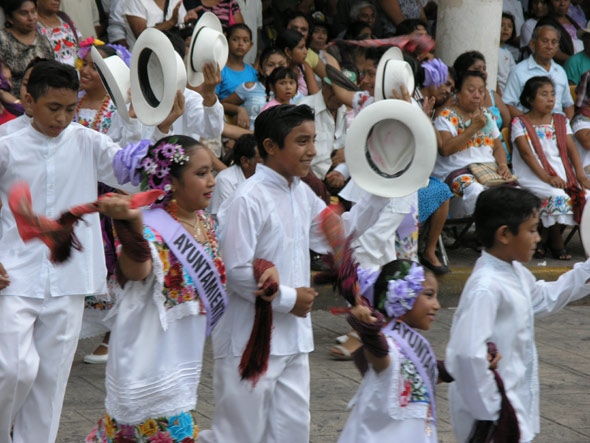|
MIRA: Multimedia Interdisciplinary Research in
Anthropology
A Collaborative and Comparative
Study of Tourism Destinations and Cultures
Program
Locations
MIRA takes place in three locations selected for their cultural, anthropological,
and ethnographic value and for their relevance to this program: Mérida,
the capital city of Yucatán; Pisté, a transcultural community
that borders Chichén Itzá; and Playa del Carmen, one of
the fastest growing international tourist attractions in the western
hemisphere, home to the world famous beach bar, the Blue Parrot. These
three locations provide the opportuntity to comparatively research the
local culture and each communities’ relationship with tourism
and tourists. The timing of this program is ideal as July is the month
one finds the most tourists from Europe and the Americas.

Dancers – Mérida en Domingo
Mérida
Mérida is rich in cultural activities — in fact, it is
rated as among the top cities in México that heavily invests
in the cultural life, activities and entertainment of its inhabitants.
Workshop participants are thus able to enjoy Mérida’s many
museums, libraries, restaurants, coffee shops, theatres, international
cinema, and contemporary dance events. Traditional cultural events are
scheduled throughout the week in Mérida for both visitors and
locals alike, including the traditional medley of music, poetry, and
dance on Thursdays in Santa Lucia Park, dancing to live Cuban big band
music of the 1940s on Tuesdays in Parque Santiago, a Sunday Afternoon
street festival of food, comedy, dance, performance art, live bands,
dancing. On Saturday and Sunday nights the downtown is closed to accommodate
the street dancing with live salsa bands and romantic music. Here you
can dance with tourists, children and octogenarians.
Playa del Carmen
Located on the “Maya Riviera” approximately 30 minutes south
of Cancun, Playa has become an increasingly popular tourist destination.
It is not the largely constructed city that one finds in Cancun, but
more along the lines of a small beach town that was identified by foreigners
in the seventies, many escaping to Playa from urban, and often cold,
locations. Playa’s main street – Avenida Quinta –
is host to a mix of Italian, French, Mexican, and US restaurants, bars,
boutiques, and hotels. The city itself is on a scale that is more European
than US. There is a preference for small, intimate, environments. The
working-class neighborhoods are a short distance away from the main
shopping and hotel district and this provides the opportuntity to compare
these different places during the program. Most recently, hotel chains
and all-inclusive resorts have begun developing the southern area of
this city towards the archaeological heritage site of Tulum. Cozumel
is a short ferry ride from Playa del Carmen.
Pisté
This transcultural community is on the road to Chichén Itzá
and most of the economy, including restaurants, hotels and inns, and
handicraft vendors, of the town is dependent on the tourism that surrounds
Chichén Itzá. A stable and small community, Pisté
is home to many of the people employed at Chichén Itzá
and home to many of the artisans who create the wooden, and stone handicrafts
that are sold in the markets throughout the Yucatán. Of particular
interest to this program is the visual culture that is manifested in
this handicraft work. For an in-depth exploration of this topic, see
Quetzil Castañeda’s article: “Art-Writing
in the Modern Maya Art World of Chichén Itzá”
published in American Ethnologist, 2004 (PDF file).
For more information on these locations, browse VisitMexico.com,
the official site of the Mexican Tourism Board, or access them directly
below:
»
Mérida
»
Chichén Itzá
»
Playa del Carmen
|
